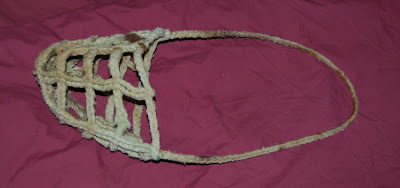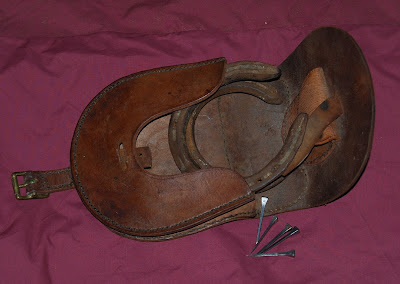
 Beside the museum are stabled our personal horses and ponies used for riding and driving, we do not, as yet, have a camel.
Beside the museum are stabled our personal horses and ponies used for riding and driving, we do not, as yet, have a camel.
 Beside the museum are stabled our personal horses and ponies used for riding and driving, we do not, as yet, have a camel.
Beside the museum are stabled our personal horses and ponies used for riding and driving, we do not, as yet, have a camel.
 One of the rarer exhibits of the museum is this leather case especially made to hold spare horseshoes and shoeing nails.
One of the rarer exhibits of the museum is this leather case especially made to hold spare horseshoes and shoeing nails. In the past cases to hold spare horseshoes were also carried on driving carriages in addition to specially made leather cases into which were fitted a set of farriers tools.
In the past cases to hold spare horseshoes were also carried on driving carriages in addition to specially made leather cases into which were fitted a set of farriers tools.



 During the 1800’s, horse brasses developed from the horse amulets, which date back some 2000 years, to the intricate shaped patterns with which we are familiar today. The earlier types were actually made out of bronze, then brass covered lead, before pure brass was used.
During the 1800’s, horse brasses developed from the horse amulets, which date back some 2000 years, to the intricate shaped patterns with which we are familiar today. The earlier types were actually made out of bronze, then brass covered lead, before pure brass was used. inscribed in Welsh, Aberteifi – Dydd Sadwrn Barlus.
inscribed in Welsh, Aberteifi – Dydd Sadwrn Barlus. The Mail Coach Guard was the only Post Office employee on board the coach and wore an official uniform of scarlet coat with gold braid and blue facings. Guards used their 3ft. long horn, a yard of tin, to warn other road users to keep out of their way and to single to toll-keepers to let the coach through. It was also used to order a fresh team of horses while a furlong away from the staging stop so that when they arrived a change of horses was ready and waiting.
The Mail Coach Guard was the only Post Office employee on board the coach and wore an official uniform of scarlet coat with gold braid and blue facings. Guards used their 3ft. long horn, a yard of tin, to warn other road users to keep out of their way and to single to toll-keepers to let the coach through. It was also used to order a fresh team of horses while a furlong away from the staging stop so that when they arrived a change of horses was ready and waiting. Every year the Royal Dublin Society host the National Craft Competition with the winners invited to display their work at the Dublin Horse Show. This stylish bridle was made by the museum's curator Rob Steinke for the 1997 competition and exhibited at that years show.It was made to fit a Clydesdale work horse and was cut, prepared and stitched entirely by hand. Note the rolled throat lash, the intricate fancy stitching on the head piece and the swelled cheekpieces. The head and browband have been lined in red patent leather and holes punched into the black leather to show the red underneath. The browband is made up with approx 40 individual brass clincher pieces and the rosettes are of the old styled beehive design.
Every year the Royal Dublin Society host the National Craft Competition with the winners invited to display their work at the Dublin Horse Show. This stylish bridle was made by the museum's curator Rob Steinke for the 1997 competition and exhibited at that years show.It was made to fit a Clydesdale work horse and was cut, prepared and stitched entirely by hand. Note the rolled throat lash, the intricate fancy stitching on the head piece and the swelled cheekpieces. The head and browband have been lined in red patent leather and holes punched into the black leather to show the red underneath. The browband is made up with approx 40 individual brass clincher pieces and the rosettes are of the old styled beehive design. One of the most rare exhibits in the museum is a Victorian children's side saddle. This beautifully made saddle is hand stitched throughout with intricate leaf designs on the seat and flaps.
One of the most rare exhibits in the museum is a Victorian children's side saddle. This beautifully made saddle is hand stitched throughout with intricate leaf designs on the seat and flaps.





Take note that on this bridle there is no bit, rather the control of the horse is effected through pressure on the nose. A chain is used to place pressure on both the front and the back on the nose and as you can see here there are numerous small teeth like ornaments hanging from the chain. This is called a Dancing Noseband as these ornements jingle up and down when in use.
The bridle and breastcollar illustrated here was hand-made in Egypt especially for Bess and the museum.
 As part of European Heritage Week 2007 the museum put on a display entitled The Working Pony in which the varying aspects of a pony's life was portrayed in different styles of harness.
As part of European Heritage Week 2007 the museum put on a display entitled The Working Pony in which the varying aspects of a pony's life was portrayed in different styles of harness.
On 15 September 2006 Young's Brewery delivered the last horsedrawn barrels of beer in London. As the two Clydesdales, Bomber and Buster, returned home so ended a 400 year old tradition of brewing at the Ram Brewery, Wandsworth.
The Museum is extremely fortunate to have this superb collar, hames and bridle dating from the 1920's donated to it by the Ram Brewery. The workmanship in these pieces of harness is truly first class. Take special note of the Ram emblem on the top of the collar and on each of the bridle winkers.
Beside the collar is the apron worn by drayman Henry on that last days delivery and which he so kindly donated to the Museum.
Around this display are photographs of the old Mountjoy Brewery in Dublin and various other Drays in multi horse hitches.
For this exhibit, the museum would like to thank the head coachman, Kevin Flynn and the directors of Young's & Co.
 An Act of Parliment in 1840's made it illeagel for women and children to work down the mines which, while it was good news for them, ment that mine owners now had to rely on small ponies to work underground.
An Act of Parliment in 1840's made it illeagel for women and children to work down the mines which, while it was good news for them, ment that mine owners now had to rely on small ponies to work underground. Although not the first to operate a horsedrawn postal service in Ireland, he is the person most remembered for his vision and business expertise. His first Mail Carts had two wheels and were pulled by a single horse. As business grew and longer distances were covered he operated four wheeled carts and Mail Coaches with either a pair or a team of four horses.
Although not the first to operate a horsedrawn postal service in Ireland, he is the person most remembered for his vision and business expertise. His first Mail Carts had two wheels and were pulled by a single horse. As business grew and longer distances were covered he operated four wheeled carts and Mail Coaches with either a pair or a team of four horses. 
